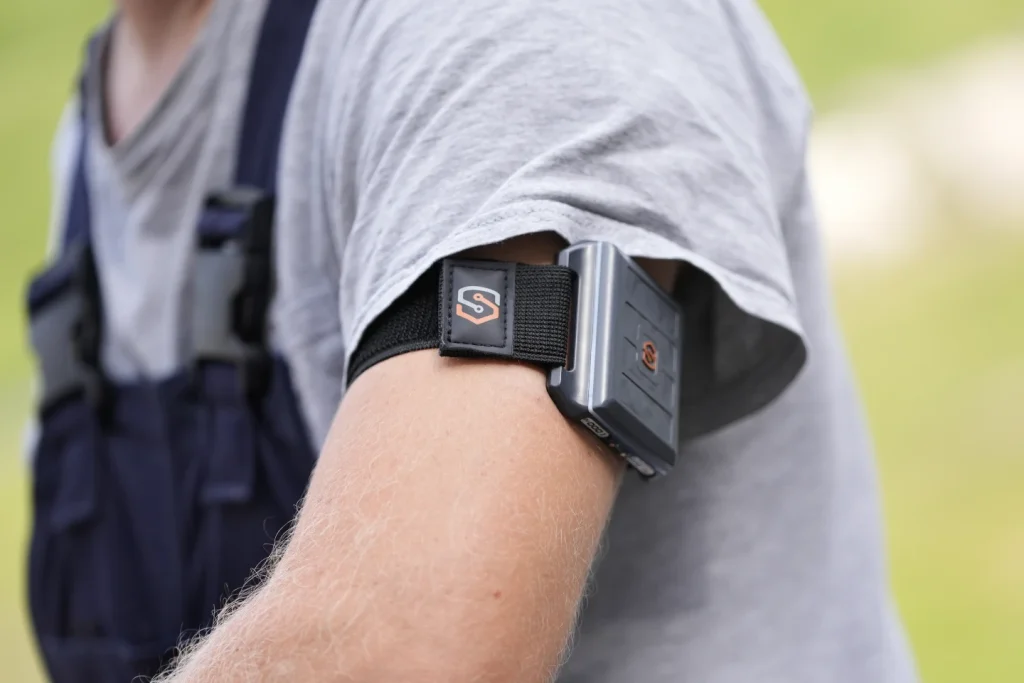On a hot summer day in Oak Ridge, Tennessee, a group of dedicated workers undertook a monumental task: decontaminating a nuclear facility by removing hazardous materials such as pipes, asbestos, and radioactive waste.
Their surroundings may have been fraught with danger due to the nature of their work, yet the immediate and pressing concern that overshadowed those hazards was the extreme heat.
Dress code for these workers included head-to-toe coveralls and fitted respirators, designed to protect them from the hazardous environment, but with little respite from the oppressive heat lingering in a building devoid of power.
To monitor their well-being, these workers wore armbands that continuously recorded their heart rates, movements, and exertion levels, alerting safety personnel of any signs of heat stress.
Stephanie Miller, a health and safety manager for a U.S. government contractor charged with cleanup operations at the Oak Ridge National Laboratory, observed the physiological data on her screen.
“Heat is one of the greatest risks that we have in this work,” Miller stated, emphasizing the alarming reality that excessive heat exposure, despite the presence of radiation and heavy metals, poses an extraordinary threat to worker safety.
As climate change escalates global temperatures, industries are increasingly investigating technological solutions to safeguard their employees. Wearable technologies, initially designed for athletes, firefighters, and military personnel, are now being adapted for use in various workplaces.
These devices provide invaluable biometric data, allowing employers to assess core body temperature — a critical health metric, as elevated body temperatures can indicate incipient heat exhaustion.
The Atlantic Council has projected that heat-induced losses in labor productivity could impose an annual economic burden of approximately $100 billion on the United States alone, underscoring the pressing need for effective heat management solutions in the workplace.
However, the introduction of such technology is not without its challenges. Concerns regarding the safeguarding of gathered medical information persist. Labor representatives argue that the data collected may potentially be used by employers to penalize workers for taking necessary breaks.
Travis Parsons, the director of occupational safety and health at the Laborers’ Health and Safety Fund of North America, voiced these apprehensions, stating, “Any time you put any device on a worker, they’re very concerned about tracking, privacy, and how you are going to use this against me.”
Parsons encapsulates the tension between advancing technology that can enhance worker safety and the potential misuse of that technology for punitive measures.
At the Oak Ridge cleanup site, the heat stress monitors worn by workers from United Cleanup Oak Ridge are an exemplary case of how technology can strive to protect worker health in hazardous conditions, aided by the U.S. Department of Energy that enforces regulations designed to prevent heat-related injuries.
Nevertheless, it is important to underscore that the majority of American workers remain unprotected from extreme heat conditions due to a lack of comprehensive federal regulations.
Many vulnerable workers may hesitate to speak up about heat stress or seek medical attention, thus exacerbating the risks they face.
In response to this pressing issue, the Biden administration proposed a rule in July aimed at protecting approximately 36 million workers from heat-related illnesses, a crucial step towards establishing a safer working environment in the face of rising temperatures.
The statistics surrounding heat exposure emphasize the urgent need for intervention. Between 1992 and 2022, nearly 986 workers died from heat exposure in the United States, according to data from the Environmental Protection Agency (EPA).
Experts acknowledge that this number is likely an underrepresentation; for example, fatalities resulting from heat-induced distress, such as a fatal fall experienced by a roofer, may not be officially attributed to heat as the underlying cause of death.
The challenge of setting occupational safety standards becomes evident when considering that individual responses to heat can vary significantly, necessitating solutions that are both flexible and reliable.
The makers of wearable devices are keenly aware of this complexity and view their innovations as essential solutions. Traditionally, employers have relied on methods such as thermometers — sometimes intrusive ones — to gauge employees’ body temperatures.
Firefighters and military personnel have even resorted to swallowing thermometer capsules for real-time temperature monitoring.
However, these methods are hardly practical for industrial environments and present challenges concerning usability and worker comfort.
Rob Somers, global environment, health and safety director at the consumer product company Perrigo, highlighted this point, noting, “That just was not going to work in our work environment.”
Instead, companies like Perrigo have turned to devices such as the armbands developed by the Atlanta-based company SlateSafety.
More than 100 employees at Perrigo’s infant formula production plants now wear these devices, which can estimate core body temperature. If a worker’s temperature reaches 101.3 degrees Fahrenheit, an alert is triggered, prompting appropriate safety measures.
Similarly, Cardinal Glass in Wisconsin has implemented the use of SlateSafety armbands for its employees laboring in exceptionally high-heat conditions while maintaining a furnace that operates at temperatures reaching 3,000 degrees Fahrenheit.
A safety manager from Cardinal Glass, Jeff Bechel, has expressed confidence in the return on investment associated with these armbands, acknowledging their critical role in safeguarding employee health in extreme environments.
As temperatures rise in conjunction with climate change, the integration of wearable technologies can serve as a vital tool for worker safety, helping to mitigate the dangers of heat exposure in various industries.
While the benefits of these advancements are clear, it is equally important to address the ethical implications surrounding employee privacy and the potential for misuse of biometric data.
The dialogue surrounding these concerns must continue, ensuring that organizations implement necessary safeguards to protect worker privacy while acknowledging the undeniable benefits the technologies provide.
The advent of advanced wearable technology, such as the sweat-analysis device developed by the Massachusetts-based Epicore Biosystems, represents a significant evolution in workplace safety, particularly in environments where the risk of dehydration and overheating is prevalent.
According to CEO Rooz Ghaffari, prior to the introduction of such innovative solutions, the common practice among workers was simply to wipe away sweat, overlooking the wealth of critical information encapsulated within bodily perspiration.
Despite promising strides in the predictions of core body temperature by similar devices in controlled experimental settings, experts express caution regarding their efficacy in more dynamic and unpredictable workplace conditions.
Variability factors, such as age, gender, and ambient humidity, complicate the reliable assessment of body temperature, as highlighted in a comprehensive review of research conducted in 2022.
For instance, employees at United Cleanup Oak Ridge often find themselves in protective equipment that induces sweating well before any actual demolition work commences, prompting managers to monitor sensor alerts closely throughout the day.
A case in point involves laborer Xavier Allison, whose wearable device vibrated during a recent heat wave while he was engaged in the strenuous removal of heavy ductwork.
Faced with additional safety protocols due to the hazardous nature of his work involving radioactive materials and asbestos, Allison was unable to step outside for respite without undergoing a laborious decontamination process, forcing him to endure intense heat in a designated room.
The wearable technology proved its value by notifying him when his body temperature cooled sufficiently to safely resume work.
According to Miller, a manager at United Cleanup, the implementation of these devices has corresponded with a marked reduction in the number of workers requiring medical intervention, which, in conjunction with annual health evaluations, allows the company to strategically align work assignments with individual health considerations.

However, this increasing reliance on data collection raises pertinent concerns surrounding employee privacy, as articulated by Adam Schwartz, privacy litigation director at the Electronic Frontier Foundation.
He warns that while such devices may ostensibly serve to protect employees, they also pose the risk of misuse, potentially leading to negative repercussions for individuals who disclose their need for breaks.
To mitigate these risks, Schwartz advocates for protocols that ensure worker autonomy, urging employers to permit voluntary participation and to exercise stringent data management practices, including the prompt deletion of unnecessary information.
Moreover, as Professor Ikusei Misaka observes, the potential for unwanted marketing exposure looms as a concern, further complicating the dynamics of employee surveillance.
The National Institute for Occupational Safety and Health underscores the necessity for a holistic approach to prevent heat-related illnesses, recommending that employers not only leverage wearable technology but also provide ample access to hydration, shade, and rest breaks.
As noted by advocates such as Juanita Constible of the Natural Resources Defense Council, without access to vital resources and time to recuperate, the utility of wearable devices may diminish, serving merely as additional burdens for workers in already taxing environments.
Thus, while wearable devices represent an important step forward in occupational health, it is clear that their integration into the workplace must be navigated carefully to ensure both the safety and the dignity of workers are upheld.
In conclusion, as industries confront the dual threats of extreme heat and hazardous working environments, the utilization of wearable technologies stands as a promising development in promoting worker safety and health.
By harnessing the power of real-time physiological monitoring, employers can better manage the risks associated with heat exposure, thereby fostering a safer and healthier workplace.
However, as we embrace these innovations, it is imperative to navigate the accompanying ethical considerations and ensure that worker privacy is maintained as a fundamental principle in the workplace.
Only through a balanced approach can we harness the full potential of wearable technologies while upholding the rights and dignity of all workers.
